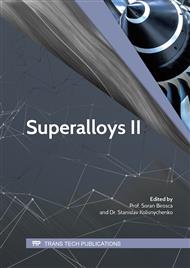p.93
p.102
p.109
p.116
p.123
p.130
p.137
p.145
p.152
Creep Damage of a Re/Ru-Containing Single Crystal Nickel-Based Superalloy at Elevated Temperature
Abstract:
By means of creep properties measurement, microstructure observation and contrast analysis of dislocation configuration, the creep behavior of a 4.5%Re/3.0%Ru-containing single crystal nickel-based superalloy at elevated temperature is investigated. Results show that the creep life of the alloy at 1040°C/160MPa is measured to be 725h to exhibit a better creep resistance at high temperature. In the primary stage of creep at high temperature, the γ phase in alloy has transformed into the N-type rafted structure along the direction vertical to the stress axis, the deformation mechanism of alloy during steady state creep is dislocations slipping in γ matrix and climbing over the rafted γ phase. In the latter period of creep, the deformation mechanism of alloy is dislocations slipping in γ matrix and shearing into the rafted γ phase. Wherein the dislocations shearing into the γ phase may cross-slip from {111} to {100} planes for forming the K-W locks to restrain the slipping and cross-slipping on {111} plane, which is thought to be the main reason of the alloy having a better creep resistance. As the creep goes on, the alternate slipping of dislocations results in the twisted of the rafted γ phase to promote the initiation and propagation of the cracks along the interfaces of γ/γ phase up to creep fracture, which is thought to be the damage and fracture mechanism of alloy during creep at high temperature.
Info:
Periodical:
Pages:
123-129
Citation:
Online since:
March 2019
Authors:
Price:
Сopyright:
© 2019 Trans Tech Publications Ltd. All Rights Reserved
Share:
Citation:



